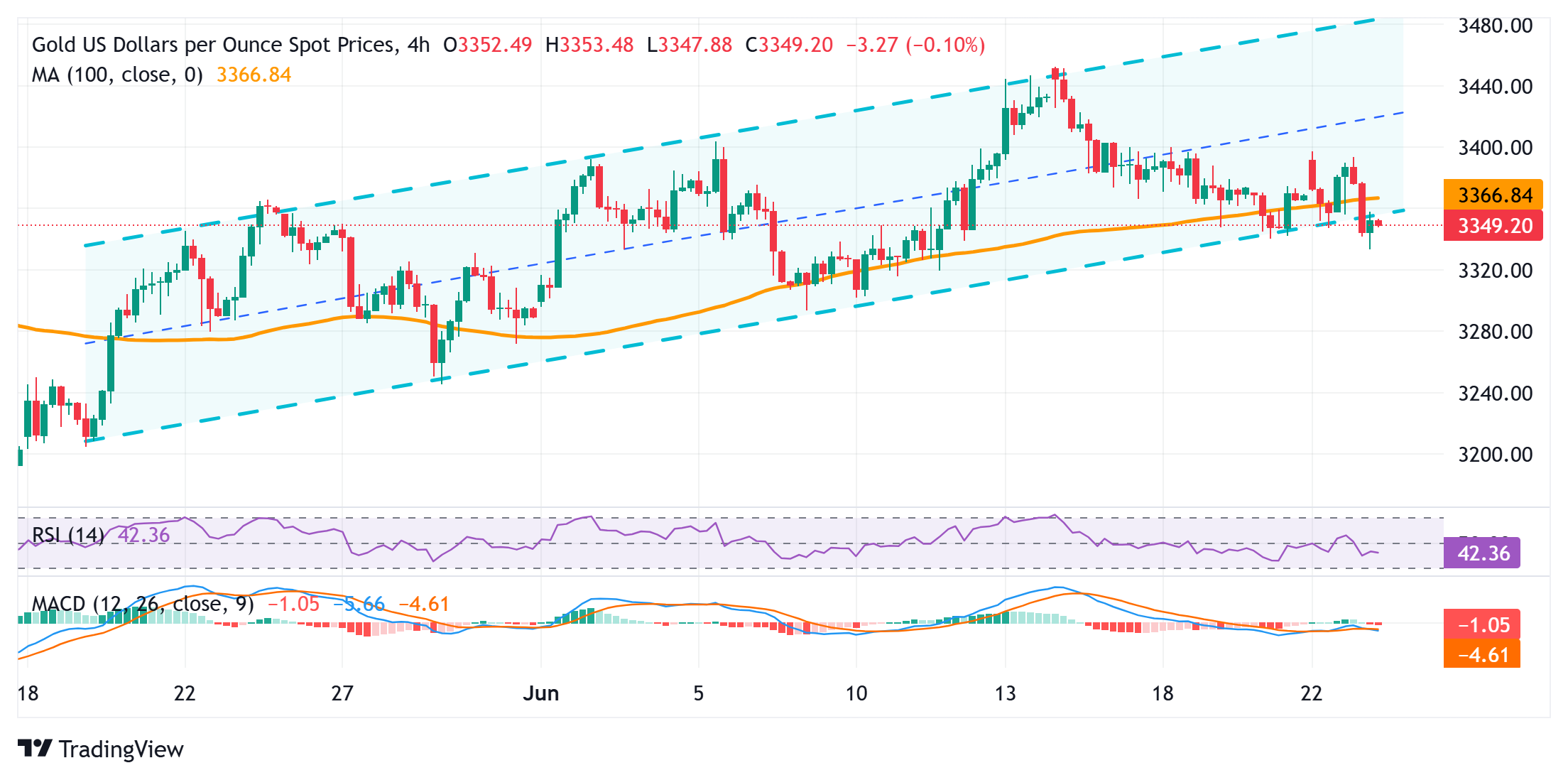- Gold price extends the previous day’s slide amid the Israel-Iran ceasefire announcement.
- July Fed rate cut bets weigh heavily on the USD, supporting the non-yielding commodity.
- The XAU/USD bears seem reluctant to commit ahead of speeches from FOMC members.
Gold price (XAU/USD) dives to a fresh two-week low during the early European session on Tuesday and seems vulnerable to slide further amid the risk-on impulse. News of the Iran-Israel ceasefire boosts investors’ confidence, which is evident from a strong rally across the global equity markets and turns out to be a key factor denting demand for the safe-haven bullion. Apart from this, the intraday downfall could further be attributed to some technical selling following the recent repeated failures near the $3,400 mark and a breakdown below short-term ascending channel support.
Meanwhile, the mixed US PMI data and dovish remarks from Federal Reserve (Fed) officials fueled speculations about the possibility of a rate cut in July. This, along with concerns about the worsening US fiscal condition and US President Donald Trump’s erratic trade policies, prompts some follow-through US Dollar (USD) selling for the second straight day. This, in turn, could offer some support to the Gold price. Traders might also opt to wait for Fed Chair Jerome Powell’s testimony for cues about the rate-cut path and placing fresh directional bets around the non-yielding yellow metal.
Daily Digest Market Movers: Gold price bears retain intraday control amid Israel-Iran ceasefire optimism
- US President Donald Trump announced that Israel and Iran have agreed to a complete and total ceasefire, providing a goodish lift to the global risk sentiment. However, reports suggest that Israel has launched some attacks against Iran.
- Moreover, Iran’s Foreign Minister, Abbas Araqchi, said that if Israel stopped its illegal aggression against the Iranian people no later than 00.30 GMT on Tuesday, Iran had no intention of continuing its response afterward, per Reuters.
- This, along with persistent trade-related uncertainties, keeps a lid on the market optimism. Apart from this, some follow-through US Dollar selling for the second straight day assists the Gold price to stall its slide to a nearly two-week low.
- Meanwhile, data released on Monday showed that S&P Global’s flash Manufacturing PMI held steady at 52 in June, while the gauge for the service sector cooled slightly to 53.1 from 53.7 and the composite index slipped to 52.8 from 53.0 in May.
- Adding to this, Federal Reserve Governor Michelle Bowman said that the time to cut rates may be fast approaching as she has grown more worried about risks to the job market and less concerned that tariffs will cause an inflation problem.
- This backs Fed Governor Christopher Waller’s view that the US central bank should consider cutting interest rates at its next policy meeting on July 29-30, which keeps the USD depressed and further supports the non-yielding yellow metal.
- Traders now look to the US economic docket – featuring the release of the Conference Board’s Consumer Confidence Index and the Richmond Manufacturing Index. This, along with speeches by influential FOMC members, will drive the USD.
- The focus, however, will remain glued to Fed Chair Jerome Powell’s testimony before the House Financial Services Committee, which could offer cues about the future rate-cut path and determine the near-term trajectory for the XAU/USD pair.
Gold price could aim to test $3,300 mark; short-term ascending channel breakdown in play

From a technical perspective, the commodity now seems to have found acceptance below the 100-period Simple Moving Average (SMA) on the 4-hour chart and is looking to extend the fall below a short-term ascending channel support. Moreover, oscillators on the said chart have been gaining negative traction and back the case for a further intraday depreciating move. Some follow-through selling below the $3,323-3,322 intermediate support will reaffirm the outlook and drag the Gold price to sub-$3,300 levels.
On the flip side, any meaningful recovery beyond the $3,368-3,370 immediate hurdle is more likely to attract fresh sellers and remain capped near the $3,400 round figure. The latter should act as a key pivotal point, which if cleared decisively could lift the Gold price to the $3,434-3,435 area en route to the $3,451-3,452 zone, or a nearly two-month top touched last Monday. The subsequent move up could extend further towards challenging the all-time peak, around the $3,500 psychological mark.
Fed FAQs
Monetary policy in the US is shaped by the Federal Reserve (Fed). The Fed has two mandates: to achieve price stability and foster full employment. Its primary tool to achieve these goals is by adjusting interest rates.
When prices are rising too quickly and inflation is above the Fed’s 2% target, it raises interest rates, increasing borrowing costs throughout the economy. This results in a stronger US Dollar (USD) as it makes the US a more attractive place for international investors to park their money.
When inflation falls below 2% or the Unemployment Rate is too high, the Fed may lower interest rates to encourage borrowing, which weighs on the Greenback.
The Federal Reserve (Fed) holds eight policy meetings a year, where the Federal Open Market Committee (FOMC) assesses economic conditions and makes monetary policy decisions.
The FOMC is attended by twelve Fed officials – the seven members of the Board of Governors, the president of the Federal Reserve Bank of New York, and four of the remaining eleven regional Reserve Bank presidents, who serve one-year terms on a rotating basis.
In extreme situations, the Federal Reserve may resort to a policy named Quantitative Easing (QE). QE is the process by which the Fed substantially increases the flow of credit in a stuck financial system.
It is a non-standard policy measure used during crises or when inflation is extremely low. It was the Fed’s weapon of choice during the Great Financial Crisis in 2008. It involves the Fed printing more Dollars and using them to buy high grade bonds from financial institutions. QE usually weakens the US Dollar.
Quantitative tightening (QT) is the reverse process of QE, whereby the Federal Reserve stops buying bonds from financial institutions and does not reinvest the principal from the bonds it holds maturing, to purchase new bonds. It is usually positive for the value of the US Dollar.







